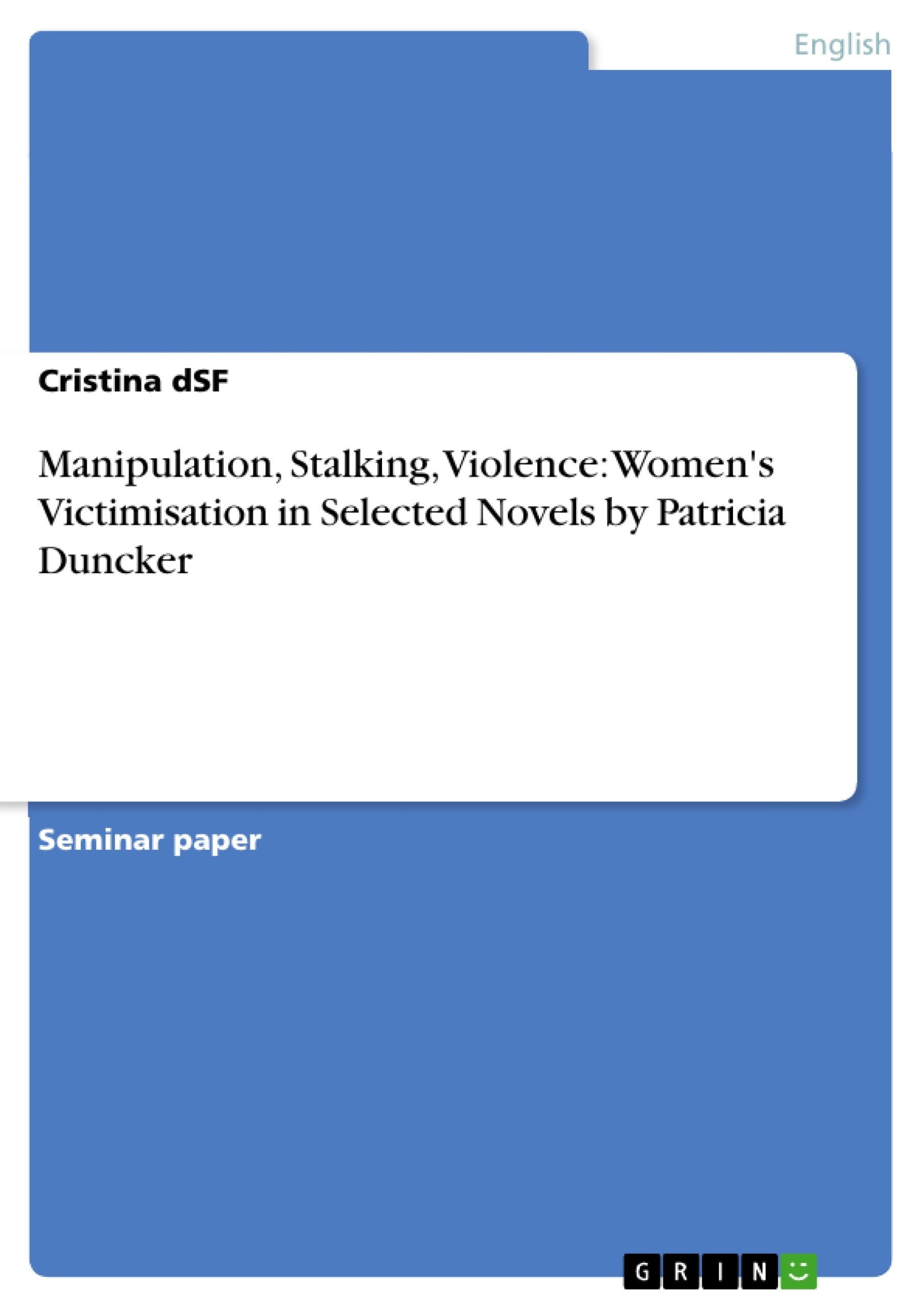In the course of the seminar “Patricia Duncker’s Fiction” we read, analysed and discussed several works by the British author that all had the similarity of being mysterious, uncanny and captivating. What made these attributes arise was not only the thrilling plot but also the character constellation. Most of the works contain only two or three protagonists and the particularity that the relationship between these protagonists only seems to be harmonious but that is actually based on an unequal balance of power. While one character is superior and dominates the thoughts and actions of the other person, the latter is not able to escape or prevent this inferiority leading to fear, confusion or even death. Interestingly enough, one can state that in Patricia Duncker’s works this unequal relationship is not arbitrary in reference to sexes but often portrays women as victims and men as offenders. In some cases the victim and the offender are even lovers, which makes it difficult to recognise the offender’s obsession with the victim from the beginning. Moreover, it is conspicuous that every work contains different types of women’s victimisation, i.e. manipulation, stalking and violence but that each work clearly focuses on one type in particular. Consequently, all works together contribute to the reader’s understanding about the range and varieties of this recurring topic.
In this term paper I will focus on this victimisation of women in Patricia Duncker’s works and analyse The Deadly Space Between, The Strange Case of the Composer and His Judge and the short story Stalker in Seven Tales of Sex and Death. At first, I will give a short definition of the term victimisation in a sociological context and explain the above mentioned typical subcategories. Then, I will analyse the focused type of victimisation in the different works in order to show that more than one of the mentioned types of victimisation appear but that one of them always predominates. To understand how the victimisation is carried out I will afterwards also look at the victim’s introspection and perception by others. In the next step, I will do a short comparison of the victimisation and victims in the different works and finally, as a conclusion, sum up the main findings and give an outlook over further possibilities to expand the topic.
Inhaltsverzeichnis (Table of Contents)
- INTRODUCTION.
- WOMEN'S VICTIMISATION: A DEFINITION
- THE DEADLY SPACE BETWEEN.
- MAIN TYPE OF VICTIMISATION: MANIPULATION
- INTROSPECTION AND PERCEPTION BY OTHERS....
- THE STRANGE CASE OF THE COMPOSER AND HIS JUDGE.............
- MAIN TYPE OF VICTIMISATION: STALKING.
- INTROSPECTION AND PERCEPTION BY OTHERS..
- SEVEN TALES OF SEX AND DEATH
- MAIN TYPE OF VICTIMISATION: VIOLENCE.
- INTROSPECTION AND PERCEPTION BY OTHERS.
- VICTIM-OFFENDER-RELATIONSHIP: A SHORT COMPARISON ....
- CONCLUSION…..........\nSOURCES.
Zielsetzung und Themenschwerpunkte (Objectives and Key Themes)
This term paper examines the recurring theme of women’s victimization in Patricia Duncker’s works, focusing on the novels "The Deadly Space Between," "The Strange Case of the Composer and His Judge," and the short story "Stalker" from "Seven Tales of Sex and Death."
- Victimisation of women in Patricia Duncker’s works.
- Types of victimisation: manipulation, stalking, and violence.
- Victim’s introspection and perception by others.
- Comparison of victimisation and victims in different works.
- Unequal power dynamics in relationships.
Zusammenfassung der Kapitel (Chapter Summaries)
The paper begins by defining victimisation in a sociological context and outlining its typical subcategories, including manipulation, stalking, and violence. The analysis then delves into each of the selected works, exploring the specific type of victimisation that dominates each narrative. The chapter on "The Deadly Space Between" explores how Isobel Hawk is manipulated by Roehm. Her initial perception of a loving relationship is slowly revealed as a carefully crafted facade designed to isolate and control her. The analysis examines how Roehm’s influence extends to her personal and professional life, manipulating her perception of herself and her work.
Schlüsselwörter (Keywords)
The paper explores key themes such as women’s victimization, manipulation, stalking, violence, unequal power dynamics, and the portrayal of victimhood in Patricia Duncker’s works.
- Arbeit zitieren
- Cristina dSF (Autor:in), 2013, Manipulation, Stalking, Violence: Women's Victimisation in Selected Novels by Patricia Duncker, München, GRIN Verlag, https://www.grin.com/document/270533



